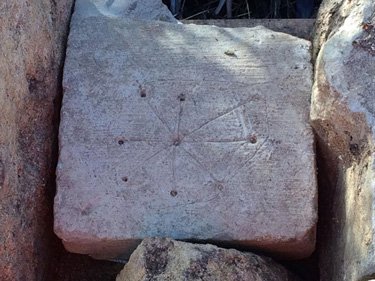The Bucks Herald:
Archaeologists working in Stoke Mandeville to prepare for HS2 [a High-Speed Railway] have begun the excavation of the remains of the medieval church of St Mary.
They have also discovered some unusual stone carvings, medieval graffiti and other markings.
Two stones with a central drilled hole from which a series of lines radiate in a circle have been uncovered at the site of St Mary’s.
Historians consider these markings to be ‘witches’ marks, created to ward off evil spirits by entrapping them in an endless line or maze.
There are several well-known examples of these across Britain both in churches as well as houses and sometimes even on furniture. However, they can also be interpreted as early sun dials, used by the church to divide up the day into morning prayer, midday prayer and evening prayer.
These ‘scratch dials’ as they are known, are usually found close to the southern door of the church as it is a position better suited for a sun dial.
At St Mary’s, one example of the markings was found low down in the west buttress close to ground level which has led archaeologists to question its purpose.
The position of the stone would have meant that it wouldn’t have served a purpose as a sun dial. This has left the possibility that it was there to ward off evil spirits or could have been a stone from a sun dial re-used as part of the church building. …
Archaeologists from Fusion JV working on behalf of HS2 Ltd at the site were also given the rare opportunity to excavate and carefully deconstruct the remains of the medieval church – something that has not been done in Britain since the 1970s.
The old church was built to serve the manor house and was located some way from the village centre. It was replaced in 1866 by a new church built closer to the village.
Though it was known that the church had been demolished, the method and extent of demolition had not been recorded and it was therefore a surprise to the archaeologists to discover, that beneath the rubble the church survived to a height of almost 5ft with floors intact.
Detailed research into the structure of the church has allowed archaeologists to piece together a history of the development of St Mary’s.
The church started off as a chapel built in about 1070, shortly after the Norman Conquest and may have been at first the private chapel belonging to the lord of the manor at that time. The church was soon extended, and an aisle added in the 1340s.
Archaeologists These new additions seem to mark a transition from a chapel used for private prayer to a church that was used by the local villagers.
Work to dismantle and excavate the church will continue into next year and archaeologists are looking forward to answering many more questions concerning the church and its architecture including discovering whether there may be a Saxon church lying beneath its floor.
—————————-
What is being excavated is a heap of rubble, all that remains of the Church of St. Mary the Virgin in the deserted village of the former Stoke Mandeville. The abandoned 11th or 12th Century Church was condemned and demolished in 1966.






Bilderback
Yes, it seems entirely reasonable to presume that’s it’s witchcraft related, or ancestor worship, or some Celtic Druid bacchanal accessory, or perhaps a sex toy, especially since it was found in the rubble of a church. Everyone knows those people are freaking nuts, amiright?
bob sykes
This is almost certainly a device for marking the solstices and equinoxes, hence the seasons. Go over to,
http://oldeuropeanculture.blogspot.com
There are lots of examples of solar instruments there, and they are not sundials.
Please Leave a Comment!